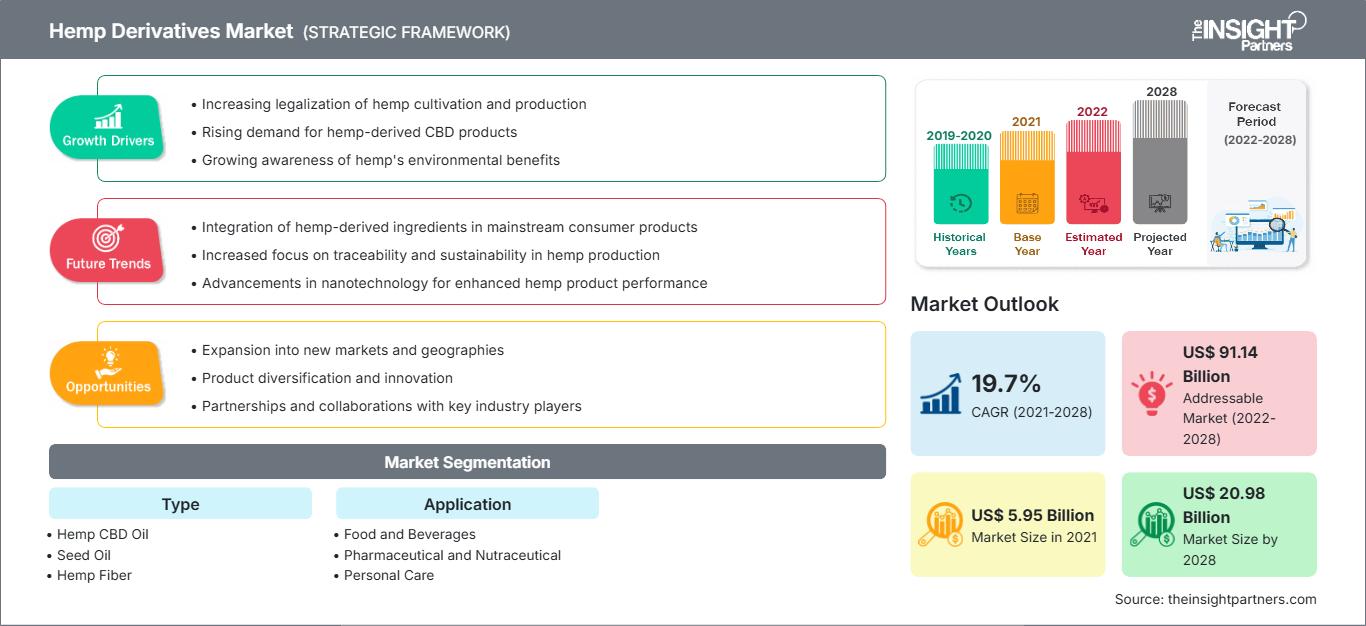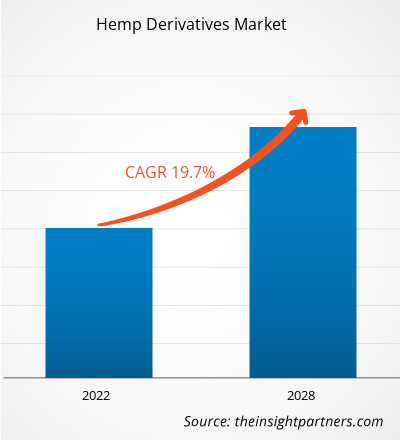Il mercato dei derivati della canapa è stato valutato a 5.953,86 milioni di dollari nel 2021 e si prevede che raggiungerà i 20.977,94 milioni di dollari entro il 2028; si prevede una crescita a un CAGR del 19,7% dal 2021 al 2028.
La canapa, o canapa industriale, è una varietà di specie di cannabis sativa, coltivata specificamente per uso industriale. I derivati della canapa, come il CBD, l'olio di semi e le fibre, sono derivati dalla canapa e trovano diverse applicazioni in diversi settori di utilizzo finale, come quello alimentare e delle bevande, farmaceutico, della cura della persona e dei mangimi.
Nel 2021, l'area Asia-Pacifico ha rappresentato la quota maggiore del mercato globale dei derivati della canapa. La crescente consapevolezza dei benefici medici dei derivati della canapa ne aumenta l'utilizzo nella regione. Inoltre, i derivati della canapa trovano diverse applicazioni nell'industria tessile. Inoltre, si stima che il fiorente mercato dei cosmetici e dei prodotti per la cura della persona nell'area Asia-Pacifico e la legalizzazione della canapa industriale negli integratori alimentari guideranno il mercato nella regione durante il periodo di previsione.
L'attuale pandemia di COVID-19 ha avuto un impatto relativamente positivo sul mercato dei derivati della canapa. La pandemia ha contribuito a sviluppare consapevolezza e interesse per il settore medico della canapa. La crisi è stata un periodo spiacevole e stressante per la maggior parte della popolazione mondiale. Pertanto, le persone in tutto il mondo hanno iniziato a consumare prodotti derivati dalla canapa per trattare ansia e stress. Diversi consumatori importanti hanno aumentato il loro consumo. Il consumo per disturbi del sonno e depressione è inoltre iperbolico. A causa della maggiore attenzione alla salute e al benessere durante la pandemia, si è assistito a un aumento delle ricerche su Google sui benefici per la salute offerti dai derivati della canapa, il che sta aumentando la consapevolezza su questi derivati. Parallelamente, molti paesi hanno subito ammanchi fiscali durante la pandemia. I governi stanno cercando fonti di entrate fiscali. La potenziale fonte potrebbe essere la legalizzazione della canapa e dei suoi derivati, che potrebbe diventare progressivamente più interessante. Un aumento della vendita di canapa e dei suoi derivati da parte di venditori legali può generare un potenziale guadagno fiscale.
Durante la pandemia di COVID-19 sono state condotte anche diverse attività di ricerca incentrate sull'uso della canapa e dei suoi derivati per il trattamento del COVID-19. Ricercatori canadesi hanno condotto uno studio per verificare se gli estratti di Cannabis sativa possano contribuire a ridurre i livelli del recettore delle cellule ospiti a cui il virus SARS-CoV-2 si aggrappa per penetrare e diffondersi. Parallelamente, STERO Biotech, un'azienda con sede in Israele, fornisce approfondimenti sull'uso di cannabis e CBD come potenziale trattamento per il COVID-19. Pertanto, diverse attività di ricerca sulla canapa e sui suoi derivati per scoprirne l'utilizzo nel trattamento del COVID-19 stanno avendo un impatto positivo sul mercato dei derivati della canapa.
Personalizza questo rapporto in base alle tue esigenze
Potrai personalizzare gratuitamente qualsiasi rapporto, comprese parti di questo rapporto, o analisi a livello di paese, pacchetto dati Excel, oltre a usufruire di grandi offerte e sconti per start-up e università
Mercato dei derivati della canapa: Approfondimenti strategici

-
Ottieni le principali tendenze chiave del mercato di questo rapporto.Questo campione GRATUITO includerà l'analisi dei dati, che vanno dalle tendenze di mercato alle stime e alle previsioni.
Approfondimenti sulla tipologia
In base alla tipologia, il mercato dei derivati della canapa è segmentato in olio di CBD di canapa, olio di semi, fibra di canapa e altri. Il segmento della fibra di canapa ha detenuto la quota maggiore del mercato nel 2021. La canapa è una pianta da fibra liberiana come la iuta, il kenaf e il lino. Queste fibre vengono ora utilizzate come rinforzi nei materiali compositi grazie alla loro biodegradabilità e alla densità inferiore rispetto alle fibre artificiali. La fibra di canapa conduce il calore, resiste alla muffa, si tinge bene, blocca la luce ultravioletta e ha proprietà antibatteriche naturali.
Alcuni dei principali attori del mercato dei derivati della canapa sono Colorado Hemp Works, Inc; Dun Agro Hemp Group; Ecofiber; Hempflax Group BV; Hempoland Sp. Z OO; Konoplex, Mh Medical Hemp Gmbh; Plains Industrial Hemp Processing Ltd; South Hemp; e BAFA Neu GmbH. I principali attori del mercato stanno adottando strategie come fusioni e acquisizioni e lanci di prodotti per espandere la loro presenza geografica e la loro base di consumatori.
In evidenza nel rapporto
- Tendenze progressive nel settore dei derivati della canapa per aiutare gli operatori a sviluppare strategie efficaci a lungo termine
- Strategie di crescita aziendale adottate dalle aziende per garantire la crescita nei mercati sviluppati e in via di sviluppo
- Analisi quantitativa del mercato globale dei derivati della canapa dal 2019 al 2028
- Stima della domanda di derivati della canapa in vari settori
- Analisi di Porter per illustrare l'efficacia di acquirenti e fornitori che operano nel settore per prevedere la crescita del mercato
- Sviluppi recenti per comprendere lo scenario competitivo del mercato e la domanda di derivati della canapa
- Tendenze e prospettive di mercato insieme ai fattori che guidano e frenano la crescita del mercato dei derivati della canapa
- Comprensione delle strategie che sostengono l'interesse commerciale per quanto riguarda la crescita del mercato globale dei derivati della canapa, aiutando nel processo decisionale
- Dimensioni del mercato dei derivati della canapa in vari nodi di mercato
- Panoramica dettagliata e segmentazione del mercato globale dei derivati della canapa, nonché delle dinamiche del settore
- Dimensioni del mercato dei derivati della canapa in varie regioni con promettenti opportunità di crescita
Le tendenze regionali e i fattori che influenzano il mercato dei derivati della canapa durante il periodo di previsione sono stati ampiamente spiegati dagli analisti di The Insight Partners. Questa sezione analizza anche i segmenti e la geografia del mercato dei derivati della canapa in Nord America, Europa, Asia-Pacifico, Medio Oriente e Africa, America meridionale e centrale.
Ambito del rapporto di mercato sui derivati della canapa
| Attributo del rapporto | Dettagli |
|---|---|
| Dimensioni del mercato in 2021 | US$ 5.95 Billion |
| Dimensioni del mercato per 2028 | US$ 20.98 Billion |
| CAGR globale (2021 - 2028) | 19.7% |
| Dati storici | 2019-2020 |
| Periodo di previsione | 2022-2028 |
| Segmenti coperti |
By Tipo
|
| Regioni e paesi coperti |
Nord America
|
| Leader di mercato e profili aziendali chiave |
|
Densità degli operatori del mercato dei derivati della canapa: comprendere il suo impatto sulle dinamiche aziendali
Il mercato dei derivati della canapa è in rapida crescita, trainato dalla crescente domanda da parte degli utenti finali, dovuta a fattori quali l'evoluzione delle preferenze dei consumatori, i progressi tecnologici e una maggiore consapevolezza dei benefici del prodotto. Con l'aumento della domanda, le aziende stanno ampliando la propria offerta, innovando per soddisfare le esigenze dei consumatori e sfruttando le tendenze emergenti, alimentando ulteriormente la crescita del mercato.

- Ottieni il Mercato dei derivati della canapa Panoramica dei principali attori chiave
- Olio di CBD di canapa
- Olio di semi
- Fibra di canapa
- Altri
Mercato dei derivati della canapa, per applicazione
- Alimenti e bevande
- Farmaceutica e nutraceutica
- Cura della persona
- Tessili
- Altri
Profili aziendali
- Colorado Hemp Works, Inc
- Dun Agro Hemp Group
- Ecofiber
- Hempflax Group BV
- Hempoland Sp. Z OO
- Konoplex
- Mh Medical Hemp Gmbh
- Plains Industrial Hemp Processing Ltd
- South Hemp
- BAFA Neu GmbH
- Analisi storica (2 anni), anno base, previsione (7 anni) con CAGR
- Analisi PEST e SWOT
- Valore/volume delle dimensioni del mercato - Globale, Regionale, Nazionale
- Industria e panorama competitivo
- Set di dati Excel
Report recenti
Testimonianze
Motivo dell'acquisto
- Processo decisionale informato
- Comprensione delle dinamiche di mercato
- Analisi competitiva
- Analisi dei clienti
- Previsioni di mercato
- Mitigazione del rischio
- Pianificazione strategica
- Giustificazione degli investimenti
- Identificazione dei mercati emergenti
- Miglioramento delle strategie di marketing
- Aumento dell'efficienza operativa
- Allineamento alle tendenze normative






















 Ottieni un campione gratuito per - Mercato dei derivati della canapa
Ottieni un campione gratuito per - Mercato dei derivati della canapa